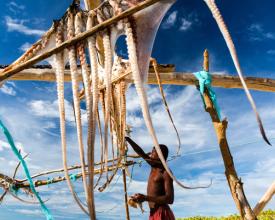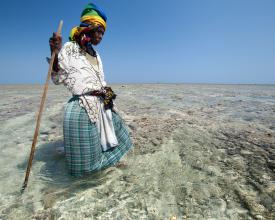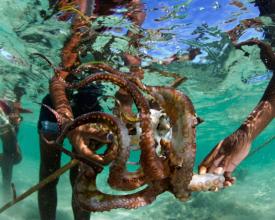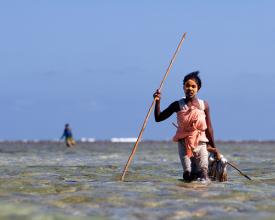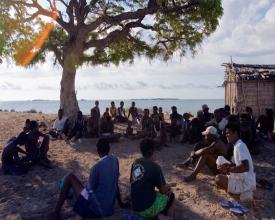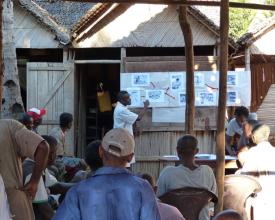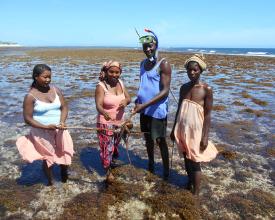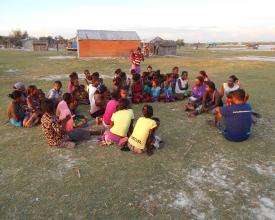
Kick-starting marine conservation through local fisheries management
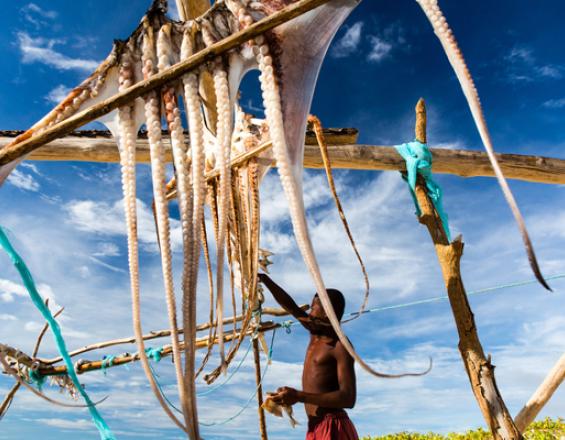
Voluntary and temporary closures of octopus fishing grounds are used as a point of entry for community-based conservation. Closures typically cover 25% of a community’s overall octopus fishing area and are in place for 2-3 months at a time. There is compelling evidence that this improves fishery yields and local incomes, thereby building support to protect natural resources through locally managed marine areas (LMMAs); areas where the management of marine resources are at least in part under community control. These LMMAs often employ marine management strategies such as bans on destructive fishing practices and community-enforced permanent no-take zones.
Contexte
Challenges addressed
Climate change, overfishing, rising coastal poverty and food insecurity, lack of conservation incentives.
Many marine conservation efforts fail. Top-down declaration that large areas are permanently off-limits to fishing all too often puts conservation at loggerheads with the needs of coastal communities, disenfranchising the people who depend on fisheries for their livelihoods. For many tropical coastal communities, forgoing fishing in protected areas represents too severe an economic sacrifice and too significant an opportunity cost.
Emplacement
Traiter
Summary of the process
The building blocks work together to create a dialogue about management, and generate strong community support. The peer-peer exchange (BB2) demonstrates the fact that similar communities have had positive experiences and helps communities to feel supported and empowered to take on the management challenge. Peer-to-peer exchange can also foster a sense of healthy competition: “If they can do it then we can do it too” or even “I bet we can have an even more productive closure than them”. Working through each of the steps in setting up the closure (BB 3-4) fosters strong community participation and ownership of the closure, ensures that local knowledge is employed and also provides a platform for discussing other potential management initiatives. Finally, community support for management generated through initial diagnostic activities (BB 1), the opening of a successful closure (BB 5), and discussions about broader management initiatives (BB 2-4), set the stage for establishment of a community governance structure that supports locally managed marine areas.
Building Blocks
Community assessment
Preliminary diagnostics are carried out with communities to assess their perception of the state of marine resources, the need for management and their motivation to take responsibility for management. To ensure adequate community ownership, it is critical that the support organisation (e.g. an NGO), does not pressure the community into agreeing to management measures that they are not necessarily motivated to enforce. If adequate recognition of a need for management and community motivation exists, the support organisation can move on to the next step.
Enabling factors
- Established relationship between community and support organization - Community recognizes a need for management and is motivated - Support organization is flexible enough to adapt to community needs and/or lack of interest - Support organization is familiar with basic diagnostic exercises, such as problem trees, concept models, etc.
Lesson learned
This first step is critical, and if carried out properly results in a community that is motivated to manage their marine resources and feels a strong sense of ownership over the initiative: - The support organization should refrain from proposing, or pressure the community from agreeing to, management measures (such as a marine reserve) before the need for management and community motivation (for management and enforcement) has been established. Otherwise the proposed action may always be perceived as an “outsider” initiative, and suffer from poor community ownership. - If adequate recognition of a need for management and community motivation exists, the support organization can move on to the next step. - The support organization must also be ready to walk away if the community expresses that it does not recognize a need for management, or is not motivated to take responsibility.
Peer-to-peer learning exchange
Fishers from target communities visit other communities already implementing temporary fishery closures or other marine management strategies. By learning directly from the real experiences of fishers from similar backgrounds to themselves, target communities realise that this is something that they can adapt to their own contexts. Experienced communities often recount not only the benefits but also the challenges that they have faced in implementing community management and thus allow new communities to prepare for, or even avoid these challenges themselves.
Enabling factors
- Funding to support a fisher-fisher exchange - An initial management interest in the visiting/target community - Key fishers representatives / respected spokespeople from visiting communities to lead discussions in their home communities - An honest and supportive hosting community with relevant experience - Planned follow up after the exchange
Lesson learned
Follow up after a peer exchange trip is crucial. The supporting organization must ensure that participants have understood key messages from the host community, synthesized what they’ve learned and are comfortable leading discussions in their home communities. Participants in the exchange trip should be community members who are legitimate in the eyes of fishers (i.e. fishers themselves) and respected. It is also helpful to have participants who are known as being sceptical and asking difficult questions –these types of people will often be the hardest to convince and the first to oppose the establishment of a closure, so having them in support of the closure from the start is a big advantage.
Collaborative closure design
Communities select a target species for temporary closures. This should be short lived and fast growing to allow clear benefits to fisher catches, and preferably economically important to ensure financial returns on the opening. A second step is selecting the area to be closed. Communities discuss and agree site selection and fishing area with the establishment of the closure. Closures are better-suited to smaller villages to avoid them being overfished on opening day. Good collaboration between villages for surveillance and benefit-sharing at opening. Consult with commercial seafood buyers prior to closure implementation, to ensure that they are aware of the closure and supportive. If they are not supportive, they may encourage fishers not to respect the closures, or refuse to buy catches from closure-implementing villages. They also need to be ready to process a glut of seafood on opening day, which can present logistical challenges. Decide on timing of closure and opening. Seasonal variations in fishing and resource use patterns may mean that an area is only suitable for closure establishment during certain times of the year.
Enabling factors
- Progressive seafood buyers who see the benefit of communities implementing closures - No decrease of price and even price incentives from seafood buyers for closure-implementing communities - Strong local leadership to galvanize support for the closures - Support from local government for the closure
Lesson learned
- Seafood buyers must be consulted early on to ensure support. - Close to villages to allow monitoring - Outside of frequently travelled routes - In a suitable habitat for the target species - Big enough to produce local fishery benefits and handle the generally large number of fishers attending an opening day - Not so big villages cannot afford to forego use of the area - Decide what tide the opening should be on. Dependent upon movements of target species - Good implication of neighbouring villages - Several closures opening simultaneously in the same zone to avoid overfishing and bad impact on habitat in one site - Consider seasonality, environmental factors - Consider any national/regional fisheries closures as this can have legal and economic ramifications - Timing of closures and openings need to be discussed fully with the fishers to ensure that everyone is party to the decision and aware of the timings - No price decrease at opening and even price incentive.
Collaborative regulation setting
The rules and regulations of the closure need to be decided upon in a village meeting setting, encouraging participation by as many people as possible to ensure a high level of community ownership and support. If the regulations are not widely agreed upon as fair, they will be very difficult to enforce. Once the community is satisfied with the rules and regulations for the closure, locals laws should be discussed openly and agreed upon. Fines should be an amount that is realistic for fishers to pay, but large enough to effectively discourage theft. It is also important to determine procedures for enforcement of the local laws at the time of its creation to avoid future delays and/or confusion if an infraction is observed. The concept of local laws is often familiar in Madagascar, and there may already be an established procedure for enforcement. In such a case, it is best to work with well-established procedures. Local laws should be formalised in regional courts to ensure legality as well as to provide strong institutional backing if a local law infraction needs to be taken to court.
Enabling factors
Existence of a legal framework for community management / customary laws such as the Dina in Madagascar.
Lesson learned
Important points when developing regulations: - Access during the closure (for fishing other species, travel) - Paying a guardian will usually be cost-prohibitive. All members of the community and neighbouring communities are considered guardians for local law discussions: - Communication of fines to people attending enforcement meetings can improve faith in the association and encourages participation in meetings - Tiered fines can be an effective way of discouraging repeat offenses but showing compassion for a first-time offender not causing hard feelings towards the management association - Illegal catches from the closure should be confiscated and sold/shared out Logistics should be discussed and agreed by entire community - Confiscating fishing gear until fine has been paid is not effective: the person may need their gear to earn money to pay the fine - Members of other communities can come to fish at opening, but have to sell their catch to the village implementing the closure
Community-based opening of closures
Closure openings can be an exciting and hectic time. All closures in an area need to open the same day (to avoid massive affluence in one site, low individual catch rates and undesirable habitat impacts.) If not well defined and organised, they can cause conflict within and between villages, as well as feelings of being cheated, and discourage the establishment of future closures (e.g. gear specifications). Opening day procedures are established well in advance, with the participation of all concerned villages and coordinated well with buyers. They need to be well communicated, so that everyone understands the rules, and so it is easy to enforce a fine on someone who does not respect them. If possible, simple catch monitoring is be carried out on the opening day, to give the community some simple and rapid feedback on the effectiveness of their closure.
Enabling factors
An effective, community-led temporary closure for octopus fishing of around 2.5 to 3 months preceding the opening day.
Rule system agreed upon by all participants.
Lesson learned
- All closures in an area should open the same day to avoid massive affluence in one site, consequently low individual catch and bad impact on habitat. - Coordinate the opening with buyers, ensuring all the products can be bought, that the price won’t decrease because of the abundance of product and, ideally, that there will be a price incentive at opening. - It is best to have one starting point, so that everyone is equidistant when it opens. One person should be in charge of announcing when the closure is officially open, and this announcement or signal should be clear. - If a traditional ceremony is to be performed, make sure adequate time has been allotted for this, and that the people performing the ceremony have adequate time to prepare to fish if needed. If catches are to be monitored, make sure that weighing stations are established, monitors prepared, preferably weighing at usual buying points so that fishers don’t have to perform an extra effort to get their catch sampled.
Resources
Impacts
Research into the effectiveness of the octopus closures has shown that they can improve catches and income, with landings from closed fishing sites increasing by more than 700% in the month following the lifting of a closure, boosting the catch per fisher per day by almost 90% over the same period. On average, we’ve found that 1 dollars’ worth of octopus left in the closed fishing site has grown to $1.81 by the end of a closure. In Madagascar, the success of early closures has led to other communities following suit, with more than 270 closures having taken place to date. Adoption continues to grow each year, not only in Madagascar, but now in other countries in the region. The approach has also been introduced to artisanal fisheries for mud crab and spiny lobster. Following the successful establishment of the closures, fishing communities across Madagascar have grouped together to establish more than 190 management associations and 70 LMMAs that ban destructive fishing practices. MIHARI, Madagascar’s LMMA network, now covers over 17% of the island’s seabed, and is championed at the highest levels of government. At the end of 2017, Blue Ventures' work in Madagascar is improving the lives of over 200,000 people. The imperative now is to bring this successful approach to coastal communities across the Indian Ocean.
Beneficiaries
Coastal fishing communities witin Madagascar.
Sustainable Development Goals
Story
At first just a single sail marks the division between sky and sea. Then there is another closer by. And more, until about twenty outrigger canoes gather on a reef flat six kilometres off the coast of southwest Madagascar. As the tide begins to recede, the traditional Vezo fishers step out of their canoes and pull them into the shallows of the reef flat. Two and a half months earlier they had closed this particular reef flat to octopus fishing. They had used a traditional law to enforce the temporary closure. It had been well respected; and today they are here to reap the rewards of their investment. Spears in hand, they fan out over the reef flat, scanning the nooks and crannies of the shallows for signs of octopus. Soon the crowd is scattered over an enormous expanse of the reef flat. Velvetine, a 60 year old octopus gleaner: “Octopus gleaning is the only way that I can earn money. Octopus is really the only seafood that we women can sell. Before we started doing octopus reserves, we were only catching two or three octopus in a day, and some days we wouldn’t catch any at all. With the reserves we make a small sacrifice, but we can still glean on other reefs, and after waiting we catch more octopus – the catch is good in the days after openings. I have more money for food and for my family. For these reasons, I want to continue with the octopus reserves.” Families begin gathering around their pirogues and putting their sails back up. One by one they set sail for the village. There they sell great bundles of freshly caught octopus to expectant buyers. Later, the collection trucks arrive to take the catch to the regional capital of Toliara. Men carry sacks full of octopus from the buyer’s stands to the collection trucks, straining under the weight. A manager for one of the export companies arrives with his assistant to check that everything is as it should be, making sure that the octopus landed by local fishers this morning will get to Toliara fresh and eventually on to the dinner plates of Europe. And so management has entered the lifeblood of this village and its people, as it has in so many others like it along the coast of southwest Madagascar. Since the first temporary closure was trialled, closures have been taken up by other villages along the coastline, giving short-term boosts in catches and fisher incomes, and sparking and building enduring support for more ambitious conservation efforts led by communities, for communities.
